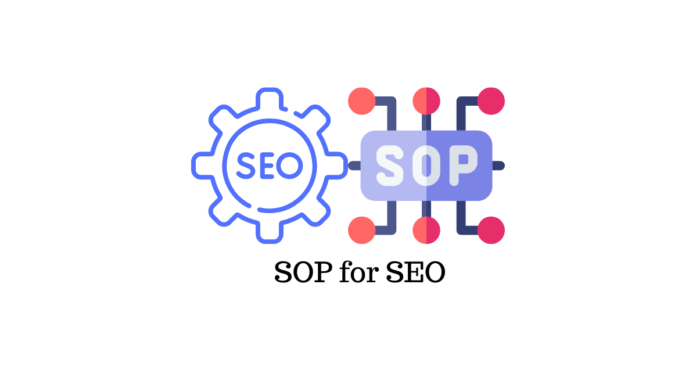Last updated - June 28, 2022
If you want to grow your business processes efficiently, ensure having Standard Operating Procedures (SOP) in place. The SOP provides a series of step-by-step instructions for your teams to carry out complicated everyday procedures. They should be succinct, easy to grasp, and include concrete measures that are simple to follow.
And when you have an in-house SEO team that looks after your website content, offsite optimization activities, and even maintaining your customer knowledge base, then crafting SOPs is inevitable. The goal of SOPs is to improve efficiency, quality, and consistency of performance while eliminating any misunderstanding or compliance issues.
Investing in high-quality SEO team content is a must if you want your campaign to succeed in any of these areas: sales, conversions, incoming traffic, or SEO ranking. Your written content is the backbone of your SEO, and while providing such services to clients, you need to have a clear approach to activities and outcomes.
Integrating different SEO activities for internal teams and clients will require you to develop an SOP. This will work as a playbook for different team members that you hire during the project.
Quick tips to consider while framing SEO SOPs
You cannot simply come up with SOPs of your SEO team unless you are clear of your goals. Therefore, the first thing you do is define a common outcome across different marketing verticals, including SEO. And once you are set with the goals, it is time to consider the tips below for SEO SOPs.
Define Level of Effort (LOE)
Coming up with a powerful SEO strategy should not be a trial-and-error approach. Instead, you need a tried and tested method that works to match your needs. To develop a highly effective potential strategy, you must work within the constraints of your specific objectives and available resources.


As a result, you need to break down all your SEO initiatives into tasks. Put those chores on a calendar to break silos between various SEO teams. Here, consider the amount of time and other resources required for each activity. And then, put them in order of importance so that the task priority is accessible across the marketing team.
Now, you may ask how to know which ones to prioritize? Well, prioritize them depending on the urgency and possible effect they have on your and your client’s business. Use SEO tools like Ahrefs, SEMrush, etc., to generate reports and share them across the team.
Also, you can leverage the services of professional freelancers to automate time-consuming but important repetitive operations like business listing, forum commenting, running technical SEO checks, etc. This list should be reviewed and updated quarterly or monthly.
Identify quick wins
One of the best SEO approaches is to look for quick victories. In search engine optimization, a “quick win” involves work that can be completed quickly and has a significant impact on your site’s search engine optimization (SEO) or sales.
Considering this factor in your SOP will help streamline activities within the team to deliver quick results effectively. Creating an SOP that incorporates quick wins requires your SEO team to ask questions. This includes asking what tasks they need to undertake today, this week, or this quarter for clients and which ones should convert at least one lead?
For example, if you want to improve your search engine optimization (SEO) campaign, your team will target websites presently ranked on the second page of search results. And this will require your SEO team to undertake outreach tasks as a part of link-building activities.
Create a timeline
While you can set the goal, you set the deadline for completing the necessary steps on your SEO roadmap. The next step is to split your actions chronologically into segments for ease of reference. While creating an SEO strategy for the whole calendar year, you could consider breaking it into quarters that serve as milestones.
You can also structure your SEO plan for short-term successes after that and start the next set of activities that yield results. Prioritize and fill in the calendar dates with your SEO tasks based on urgency and effect, and then prioritize non-urgent and impactful ones having a long-term influence. Finally, fill the remaining time slots with activities that can be continued indefinitely as a part of ongoing SEO activities.
Also, you need to consider how long each activity will take, who will accomplish those tasks, and how you will evaluate it. Therefore, you need to assess the effectiveness of each task while creating your SOPs for SEO.
Create SEO-focused content
Lastly, you need to consider the content part as well. Here, the SOP will have your SEO team consider whether to revamp the content to match the end goal. Also, your SEO can impact when you are creating content from scratch. Therefore, you need to reconsider the SEO activities and plan your output after that.
New content fills in knowledge gaps and keeps you abreast of what your rivals write about. But you’ll need to master the art of keyword selection as a part of SEO activities. This is especially true if you seek high rankings in search engine results and increase sales for your clients.
Whenever you think of a new idea, you need to start from zero, which takes more time and money. And therefore, your SOP should often include optimizing your current content that helps you rank higher for keywords and keep your brand consistent in the search results.
When designing an SEO plan for your business and clients, think of the subject, keywords, metadata, and an outline when brainstorming SOPs. Plan out activities that encourage users to stay longer on your site, look for internal connecting possibilities, and enhance content to drive interactions.
Key SEO Standard Operating Procedures
When you have the SEO goals ready and KPIs planned out, you need to consider crafting SOPs. These standard operating procedures will work as guidelines for everyone in your SEO team and help realize milestones timely. Here are some of the key SEO SOPs that can help you get started in the right direction.
Keyword research
SOP for keyword research should show team members how to use tools like Google’s free keyword planner and Ahrefs, select relevant terms, and do keyword volume and projection searches, amongst the other tasks.


Use keywords to create SEO-based content
This is a crucial SOP that will have your team maximize the effectiveness of your title tags, publish lengthy content, leverage user experience signals, assess keyword popularity using SEMrush, and plan data-backed content.
Enhance your website’s on-page SEO
Create a better understanding of optimizing your page’s performance, providing alt tags for images, planning keyword placement, and using Schema markup amongst other things.
Forum backlinks
Discover ways to find high-quality forums and provide comments that bring value while also linking back to a page on your website. This is a must-have SOP with ongoing engagement that drives better SEO results.
Get backlinks from existing content
You can create this SOP to guide you through the process of getting backlinks to current content on your website. Also, have your SEO team discover top-ranking sites, analyze their backlink profiles, and conduct outreach, among other things.
Identify and get a backlink from competitors’ sources
When you have competition analysis as a part of your SOP, it should include SEO activity to track sources from which your competitors get backlinks. This method is useful for teams to discover “resource pages” on the internet and request those websites link to your website as well.
Identify and leverage broken links
One of the reasons to have SOPs is to drive consistency. One way to introduce consistency includes identifying broken links. Your overall SEO strategy should include identifying broken links on your site, restoring these broken pages, and capitalizing on your competitor’s broken links.
Conclusion
Perhaps the biggest impediment to growing your organization into a bigger, more powerful version of itself is not competitors but rather a failure to strategize SEO activities.
Most of the business success relies on your ability to scale your SEO initiatives. For this, you will need to have SOPs and mechanisms that drive each related activity within the organization.
Having an SOP for SEO can help you gain an edge over your competition. Despite the increasing difficulty of ranking, streamlining your SEO and content activities help deliver results that matter.











